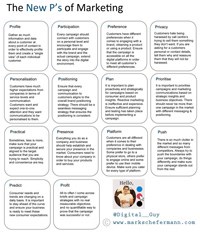After studying a B Com Marketing Management at the University of Pretoria for two years, all the lecturers seemed to drill into us were the "4 Ps of Marketing". It appeared that that was all there was to marketing. Later on they started to teach us about the extra "3 Ps" namely "People", "Process" and "Physical Evidence".
Therefore, it's not surprising that on completing four years of studying, the "7 Ps" were the most important factors of a successful marketing campaign. And here they are...
Now that I have been working for a number of years, especially with my experience in the Digital Marketing space, I personally feel that these "7 Ps" just don't cut it any more. There is so much more to consider. Consumer behaviour has changed drastically, that is why I recommend the ZMOT marketing mental model. The marketing game has changed and I hope that universities have included this thinking and updated their marketing content and curriculum.
In a number of private schools, students as young as Grade 6 (12 years old) are required to have an iPad. This may sound absurd but we need to teach students to feel comfortable with this technology and prepare them for their future, not ours. These students will have an advantage in their careers as this has been included into their early schooling curriculum. At a Grade 6 level, they are completing projects on their iPads and presenting their work to their fellow class mates. I beg you to differ that these aren't skills that they are going to one day be required in their careers? I am definitely not saying that the "7 Ps" are redundant; I just think they have evolved.
The new "Ps" of marketing
The traditional 7 Ps of marketing have evolved. Here is my take on a couple of additional "Ps" that I feel should be added to the marketing mix.
8. Profile:
It is important to gather as much information and data about a customer at every point of contact in order to effectively profile them and create a "single view" of each individual customer. Having a consumer-centric approach to marketing will ensure that you understand your target audience, what their needs are, what messaging and communication platform is most relevant to them based on their behaviour and preferences.
9. Participation:
Every campaign should connect with customers on a personal level and encourage them to participate and engage with the brand and the actual campaign. Marketers now have the opportunity to extend the story into the digital environment. Create brand ambassadors by giving them something to talk about and give them a reason to connect with you, putting a Facebook and Twitter logo on your add is no longer sufficient. To find out more on how to achieve this effectively, I would recommend watching "The Thank You Economy" by Gary Vaynerchuk.
10. Preference:
Customers have different preferences when it comes to engaging with a brand, obtaining a product, or using a product. It is critical for marketers to ensure that a campaign is accessible on all relevant digital platforms (web, mobile, social media, search). Campaign integration is so important, what a consumer sees on TV, hears on radio and sees on a billboard on the way to work should be the same campaign that he/she experiences online.
11. Privacy:
Customers hate being harassed by call centres trying to sell them something they don't want. If you are asking for a customers personal or contact details, tell them why and reassure them that they will not be harassed. How many times do you complete some sort of lead form online and then get harassed for the next couple of months by all sorts of call centres trying to sell you something. I believe customers will happily provide you with their details and preferences as long as you give them a good enough reason and explain how it will benefit them.
12. Personalisation:
Customers have much higher expectations from companies in terms of service levels and communications. Customers want and expect one-to-one attention and they want communications to be personalised to them. Gone are the days where consumers phone a call centre to complain or ask questions they might have regarding a product or service, we are now in the era of the "social media" call centre. Consumers will now go to a brand's Facebook and Twitter profile to post their complaint or query, this way they get quicker feedback, they don't have to hold on to a phone call for long periods of time and they feel as if their voice has been heard. The sad reality is that because of this trend, brands are dropping the ball with the traditional channels like a call centre and email addresses.
13. Positioning:
Ensure that every campaign and communication to consumers aligns to the overall brand positioning strategy. There should be a seamless messaging strategy that ensures the positioning is consistent. So often there is no overarching brand positioning strategy which results in campaigns looking and sounding completely different. Managers aren't sure what their brand positioning is and therefore consumers have no idea what your brand stands for. The "Celery Test" by Simon Sinek is the best metaphor for this that I have come across. Make sure you know what your "why" is and then stick to it.
14. Plan:
It is important to plan proactively and strategically for campaigns based on consumer and product insights. Reactive marketing is ineffective and expensive. Ensure sufficient planning and testing has taken place before implementing a campaign. There needs to be a long-term and short-term marketing plan or road map. Campaigns should happen because of a very specific business objective versus the scenario where a marketer has a KPI (key performance indicator) that says in a year there needs to be two marketing campaigns. Even the launch date should be based on a very specific insight, if you have all of this in place then you won't worry about competitors launching campaigns that compete with your business as you have your roadmap in place and you can see the "bigger picture".
15. Prioritise:
It is important to prioritise campaigns and marketing communications based on strategic insights, consumer trends and business objectives. There should never be more than one campaign in the market with a different messaging and positioning. This results in clutter and the consumer not knowing what you are trying to tell them.
16. Practical:
Sometimes, less is more, make sure that your campaign is practical and aligned to the target audience that you are trying to reach. Simplicity and convenience is key. Some of the most effective campaigns that I have come across are exceptionally simple.
17. Presence:
Everything you do as a company and a business should help establish and secure your presence in the market. Consumers need to know about your company in order to buy your products and services. This "presence" must also always align to your "why" and be consistent with the brand positioning strategy. If you don't have budgets to have a presence always in the market then make sure that when you do, you get the highest possible ROI (return on investment).
18. Platform:
Customers are all different when it comes to their preferences in dealing with companies and businesses. Some prefer to go to a physical store, others prefer to engage online, while others prefer to use their mobile device. Make sure you cater for every type of platform and consumer. If you are targeting an audience in a lower LSM and your insights show that their only access to the internet is a mobile device, don't create a campaign that evolves around a Facebook application. Relevance is important when it comes to any campaign strategy, make sure your campaign is suitable and practical for the audience you are trying to reach.
19. Push:
There is a lot of clutter in the market and many different messages from competitors. Always try to push the boundaries with your campaign, do things differently, and make sure your campaign stands out from the rest. Consumers appreciate campaigns that are innovative, that engage with them and are different from the stock standard print and TV ads that they come across every day.
20. Predict:
Consumer needs and trends are changing on a daily basis. It is important to stay ahead of the curve and ensure your business is ready to meet these new consumer expectations. Technology is evolving at a rapid rate, and with this so are consumers.
21. Profit
All too often I come across briefs and campaign strategies with no real measurable objectives and no quantifiable way to prove that the campaign was successful or not. If your campaign is to increase brand awareness, then how are you going to measure these? There should always be a set of objectives that can be measured in some form or another.
These are just a couple of new marketing "Ps" that I believe should form part of the consideration mix when compiling any sort of marketing strategy. The digital world is evolving, and therefore so are our consumers. Make sure you keep up with these fast changing times and remain relevant to your consumers.


























































